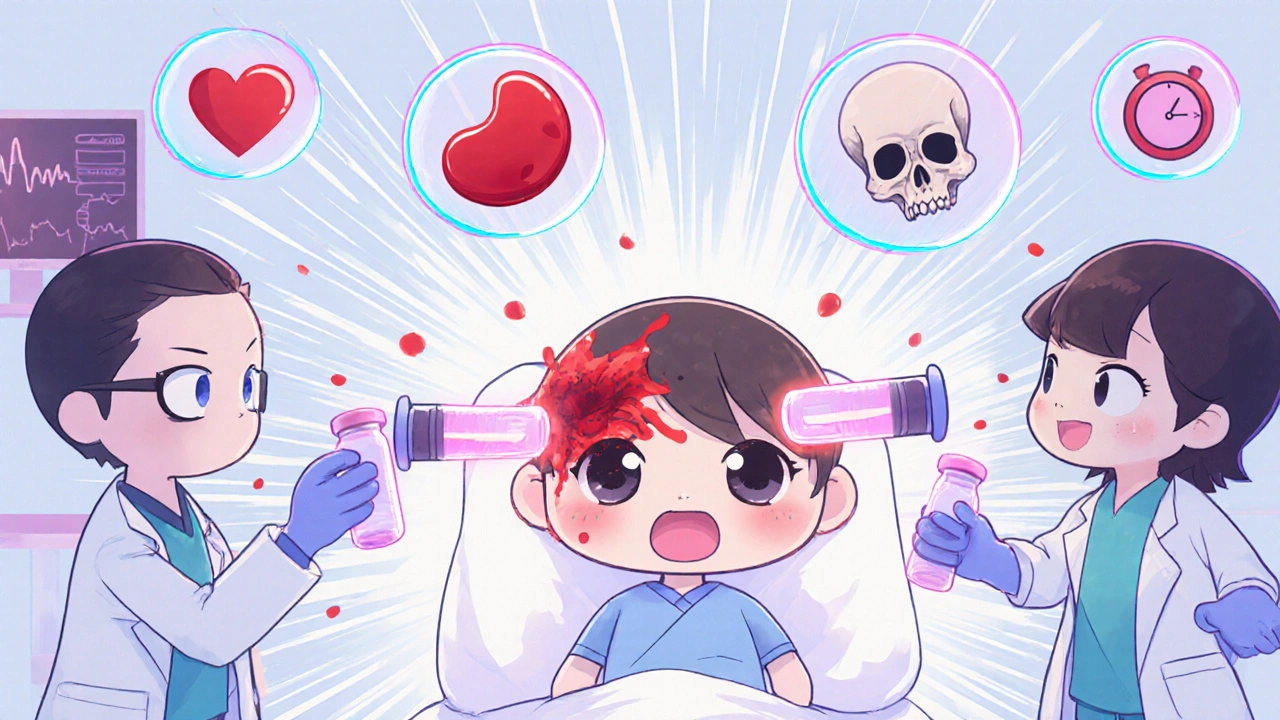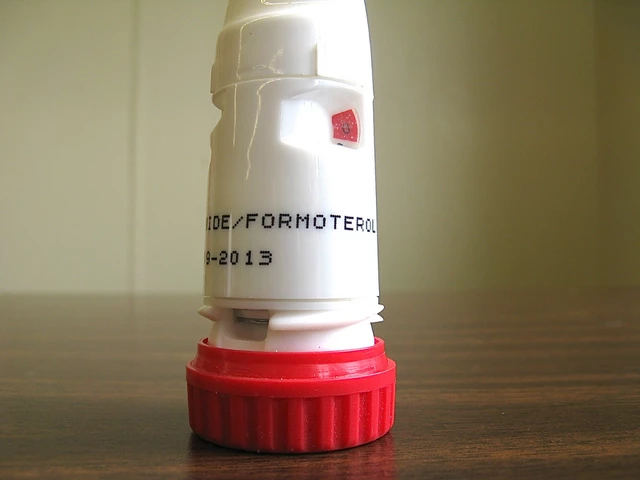When someone on blood thinners suffers a major bleed - like a fall that causes a brain hemorrhage or a stomach ulcer that won’t stop bleeding - time isn’t just money. It’s life. These medications, designed to prevent deadly clots, can turn dangerous in an emergency. But the good news? We now have tools to reverse them quickly, precisely, and often life-savingly. The question isn’t whether they can be reversed - it’s which reversal agent works for which drug, and when.
Why Blood Thinners Need Reversal Agents
Blood thinners, or anticoagulants, are taken daily by millions to prevent strokes, heart attacks, and pulmonary embolisms. The most common are warfarin (Coumadin) and the newer class called NOACs - dabigatran (Pradaxa), rivaroxaban (Xarelto), apixaban (Eliquis), and edoxaban (Savaysa). These drugs work differently. Warfarin blocks vitamin K, while NOACs directly inhibit clotting factors. That’s why you can’t use the same fix for all of them.Before 2015, doctors had few options for NOACs. If a patient on Xarelto or Eliquis started bleeding internally, they’d rely on general measures: stopping the drug, giving IV fluids, transfusing blood, or using prothrombin complex concentrate (PCC). But those weren’t targeted. They didn’t neutralize the drug - they just tried to outpace its effect. And they often failed.
Now, we have two FDA-approved reversal agents that act like molecular magnets - grabbing the anticoagulant and pulling it out of circulation. This isn’t theory. It’s real-world medicine used in ERs and trauma centers every day.
idarucizumab: The Dabigatran Killer
If someone is on dabigatran (Pradaxa) and has a brain bleed or major GI hemorrhage, idarucizumab (Praxbind) is the go-to. It’s a monoclonal antibody fragment - basically, a lab-made protein that binds to dabigatran with near-perfect precision. In clinical trials, it reversed anticoagulation in 100% of patients within minutes.How it works: Two vials (2.5 grams each) are given as IV boluses, no more than 15 minutes apart. Within 5 minutes, clotting times return to normal. The effect lasts about 24 hours. That’s enough time to stabilize the patient, get them to surgery, or stop the bleed.
But there’s a catch. In 23% of cases, dabigatran levels bounce back after 24 hours because the drug is still circulating in the body, especially in patients with kidney problems. That’s why 10 patients in the RE-VERSE AD trial needed a second dose. Emergency teams now keep extra vials on hand and monitor patients for 24-48 hours.
Success rates are high: 93% of patients needing urgent surgery had normal hemostasis. Mortality dropped to 11% in brain bleed cases - far better than the 30-40% seen before reversal agents existed. And unlike other options, idarucizumab doesn’t increase the risk of clots. Thromboembolic events? Just 5%.
andexanet alfa: Tackling Factor Xa Inhibitors
Rivaroxaban, apixaban, and edoxaban all block Factor Xa - a key protein in the clotting cascade. To reverse them, you need something that binds to Factor Xa inhibitors like a shield. That’s andexanet alfa (AndexXa).It’s not a simple injection. Andexanet alfa is given as a two-hour IV infusion, followed by a maintenance drip. It works by acting as a decoy - it soaks up the anticoagulant so your body can clot again. In the ANNEXA-4 trial, 83% of patients with life-threatening bleeds stopped bleeding within 2.5 hours.
It’s effective - but not without risk. About 14% of patients on andexanet alfa developed new clots: heart attacks, strokes, or deep vein thrombosis. That’s nearly double the 8% seen with 4F-PCC. Mortality is similar - around 24% - but the added clot risk makes doctors cautious. The FDA even issued a warning.
Because of this, many hospitals reserve andexanet alfa for the worst cases: intracranial hemorrhage, massive GI bleeding, or when surgery can’t wait. It’s not for minor bleeds. And it’s not approved for planned surgeries - only emergencies.

4F-PCC: The Budget-Friendly Workhorse
Not every hospital can afford idarucizumab ($3,800 per dose) or andexanet alfa ($17,900 per treatment). That’s where four-factor prothrombin complex concentrate (4F-PCC) comes in. It’s a blood-derived product packed with clotting factors II, VII, IX, and X. It’s been used for decades to reverse warfarin - and now it’s the fallback for NOACs when specific agents aren’t available.It’s cheaper - $1,500 to $3,000 per dose. And it works. Studies show it achieves hemostasis in about 77% of cases, similar to andexanet alfa. But it’s not targeted. It floods the system with clotting proteins, which can trigger clots in patients already at risk. That’s why it’s often used in community hospitals or when specific agents aren’t stocked.
Some experts use it as a first-line option for Factor Xa inhibitors when andexanet alfa isn’t accessible. Others wait. The decision often comes down to speed, cost, and risk tolerance.
What Happens in the ER?
When a patient arrives with a bleed and they’re on blood thinners, the ER team doesn’t guess. They test. First, they ask: What drug are they on? When was the last dose? Do they have kidney disease? Then they order labs:- Dilute thrombin time (dTT) or ecarin clotting time (ECT) for dabigatran
- Anti-Factor Xa assay for rivaroxaban, apixaban, edoxaban
If those tests aren’t available - and they often aren’t in small hospitals - they rely on clinical judgment. A patient on Eliquis with a head injury? Assume the drug is still active. Give 4F-PCC or andexanet alfa if available. Don’t wait.
Time matters. The best outcomes happen when reversal starts within two hours of bleeding onset. After that, brain swelling, organ damage, or blood loss can become irreversible.
Emergency teams now train regularly. The American College of Cardiology recommends 4 hours of certification for staff handling anticoagulant reversal. Protocols are posted in ERs. Reversal kits are kept on standby.

Cost vs. Survival: The Hard Choices
Let’s be real: these drugs are expensive. A single dose of andexanet alfa costs more than a year’s supply of Eliquis. Many hospitals restrict its use to patients with intracranial hemorrhage or uncontrolled bleeding. Pharmacists report that 43% of institutions won’t use it unless the patient is coding.Idarucizumab is cheaper, but still out of reach for some. One hospital in Ohio told me they keep only one vial on hand - enough for one patient. If the second patient needs it, they scramble.
4F-PCC is the workhorse. It’s not perfect, but it’s reliable. In a 2022 survey of 127 neurosurgeons, 79% said time to hemostasis was the most important factor. Idarucizumab achieved that in 2.5 hours. 4F-PCC took 4.7 hours. But if you don’t have idarucizumab, you use what you’ve got.
The Future: A Universal Reversal Agent?
The holy grail? A single drug that reverses all anticoagulants - warfarin, dabigatran, Xarelto, even heparin. Enter ciraparantag (PER977). Developed by Perosphere Pharmaceuticals, it’s in Phase III trials as of 2024. Early data shows it reverses dabigatran in under 10 minutes and works on Factor Xa inhibitors too.If approved, it could change everything. One drug. One protocol. One kit. No more guessing. No more stock shortages. No more cost barriers.
But it’s not here yet. Until then, we work with what we have. And that’s enough - if you know how to use it.
What Patients Should Know
If you’re on a blood thinner, carry a card or app listing your drug, dose, and doctor’s contact info. Tell every ER provider you see - even if you’re unconscious, someone needs to know.Don’t assume your drug can’t be reversed. It can. But speed saves lives. If you fall, hit your head, or start vomiting blood, get to the hospital immediately. Don’t wait. Don’t call your primary care doctor first. Go to the ER.
And if you’re a caregiver: Learn the signs of major bleeding - confusion, severe headache, dark stools, vomiting blood, swelling in limbs. These aren’t normal side effects. They’re emergencies.
Can blood thinners be reversed at home?
No. Reversal agents like idarucizumab and andexanet alfa require intravenous administration and close monitoring in a hospital setting. There are no oral or at-home reversal options. If bleeding occurs, call 911 or go to the nearest emergency room immediately.
How long does it take for reversal agents to work?
Idarucizumab works within 5 minutes, with full reversal in under 15 minutes. Andexanet alfa starts working within minutes, but the full two-hour infusion is needed for sustained effect. 4F-PCC begins working in 10-30 minutes but may take longer to fully stabilize clotting.
Do reversal agents cause blood clots?
Yes, but the risk varies. Andexanet alfa causes clots in about 14% of patients. Idarucizumab has a very low clot risk - around 5%. 4F-PCC carries a moderate risk of 8-10%. Doctors weigh this risk against the danger of uncontrolled bleeding. In life-threatening cases, the clot risk is often acceptable.
What if I don’t know which blood thinner I’m on?
Emergency teams will test your blood for anticoagulant activity. Labs can detect whether you’re on a direct thrombin inhibitor (like dabigatran) or a Factor Xa inhibitor (like apixaban). If you’re unsure, bring your pill bottles or a list of medications. If you’re unconscious, your family or pharmacy records can help.
Are reversal agents covered by insurance?
Most major insurers cover idarucizumab and andexanet alfa for approved emergency uses. However, prior authorization may be required, and some plans limit use to specific hospitals or conditions. 4F-PCC is more widely covered due to lower cost. Patients should check with their insurer, but in emergencies, treatment is provided regardless of payment status.



